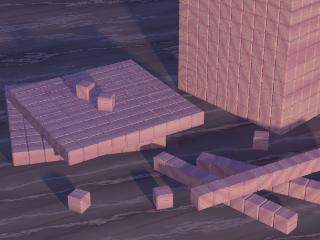By Michael Hartley
When I was in kindergarten, my parents gave me a set of wooden blocks that helped me develop a sense of number. The blocks also helped with addition and subtraction of single-digit numbers.
In grade school, kids move beyond single-digit numbers, and have to pick up the idea of 'carrying' or 'borrowing'. Well, my parents also gave me a set of blocks to help out here too!

Well, you can't download wooden blocks from a website, but on this page, you can get the next best thing. A printable set of cards or tiles, just like the blocks, that you can use to teach kids how to add and subtract numbers of more than one digit.
By the way, this site has other tool for teaching multi-digit numbers, called foldable number sheets. In the movie on that page, you'll see me using these 1, 10 and 100 tiles as well - the wooden version of the tiles, not the printable version.
The first thing you'll need to do is download and print the tiles. Make a lot of copies - 20 should be enough - then cut them out. Cardboard is better, but paper is fine too. Then you'll have a whole bunch of big square tiles representing 100, medium sized long rectangles representing 10, and small squares representing 1. You are now on the way to helping you child master the art of multi-digit subtraction!
It will take quite a few sessions. Remember to keep the atmosphere positive throughout, and keep the kid focused on the activity.
Phase 1
The goal of this phase is to get your child used to the tiles. Teach him or her how to change a number (such as 472) into the right number of tiles of each type (4 big, 7 medium, and 2 small). Also, make sure he or she can write down the correct number when you show him or here a set of tiles. This helps your child understand the meaning of our modern decimal number notation.
Phase 2
Now you are ready to teach your child addition with no carry. Given two numbers, say 123 and 472, have the child separate out the correct number of tiles for 123, and the correct number for 472. Then combine all the tiles, and ask the child what number they now have. After a while, it will be easy for your child to add large numbers using the tiles. You are now ready for phase 3!
Phase 3
When you feel your child is ready, sneak in an addition sum requiring carry, for example, 207 + 543. When they discover the have 10 small squares, they may write an answer like 7410. Or express puzzlement. Then, it's time to gently teach the child that when there are too many tiles of some size, they should exchange some for a larger tile. Here, the ten small tiles get changed into one medium sized tile, and the answer is 750. Make sure the child also knows he or she can change 10 medium tiles for one big one, via sums like 333 + 484.
Important : Be sure to show the child how the 'tiles method' of adding corresponds to the 'schoolbook method' of adding columns, and carrying ones.
Now, you are ready to move on to subtraction!
Phase 4
First, show the child how to do subtraction sums with no borrowing using the tiles. Here, for example, is how to solve 785 - 324.
- First change the number 785 into tiles (that is, 7 large, 8 medium and 5 small tiles).
- Then, remove enough tiles to make up 324 (three large, 2 medium and 4 small).
- From the remaining tiles (4 large, 6 medium and 1 small) you know the answer : 461.
Phase 5
Finally, when your kid is ready, throw in a subtraction problem requiring borrowing, say 738 - 245. The poor kid will be baffled at first - how can he or she remove four medium sized tiles, when there's only three to begin with? Well, remind him or her that a large square tile is the same as ten medium ones. Then, the 7 large, 3 medium and 8 small become 6 large, 13 medium and 8 small, and there's more than enough to extract the 2, 4 and 5, leaving 4 large, 9 medium and 3 small. In this way, the child can get the answer (493).
Go through enough examples like this so your child gets used to it. Give him or her some practice questions to work out. And, very important, show the child how the 'tiles method' of subtraction corresponds with the 'schoolbook method' of borrowing 1's from the 100's column into the 10's, or borrowing from the 10's columns into the 1's.
In this way, these tiles will help your kid master the art of multi-digit addition and subtraction!
